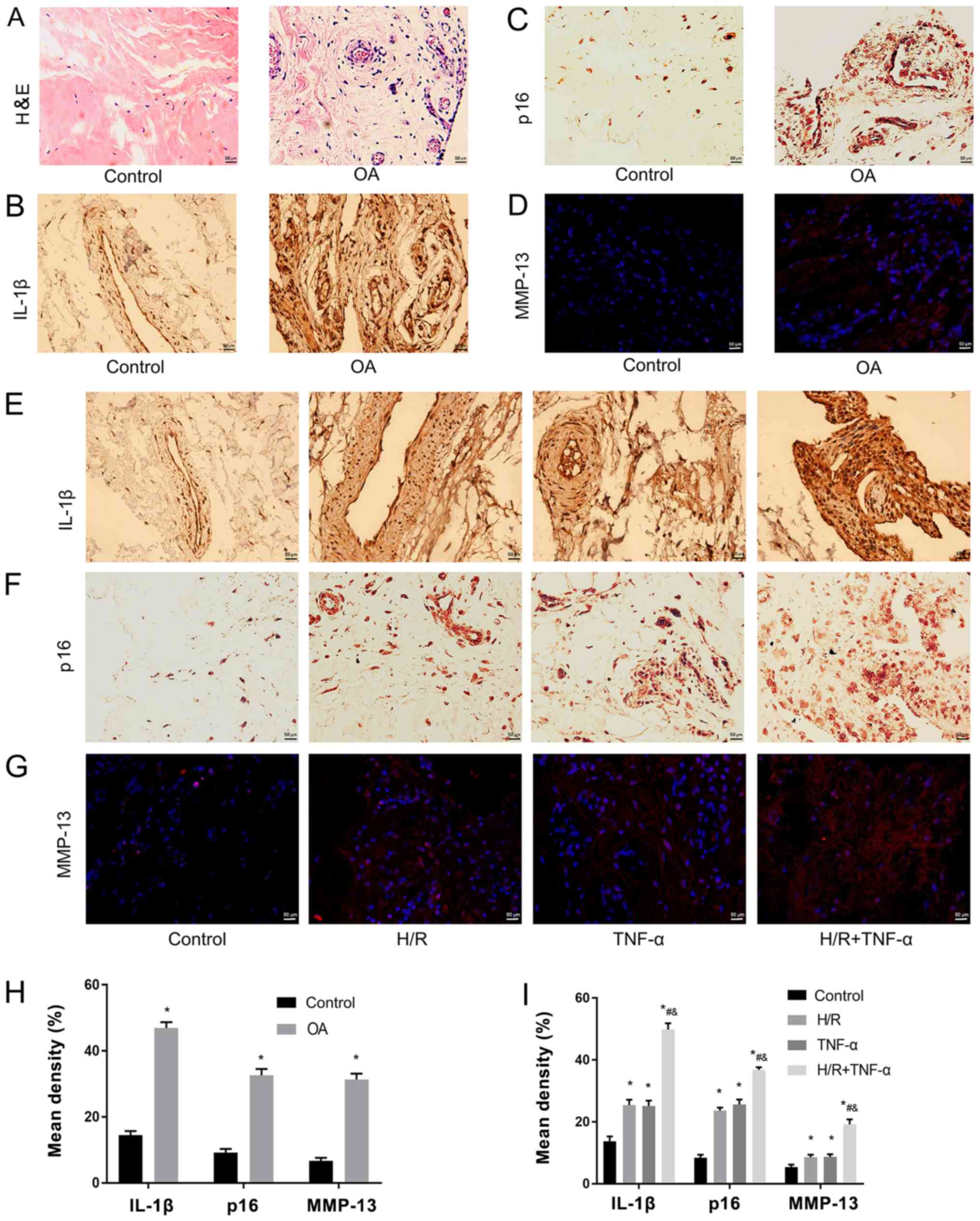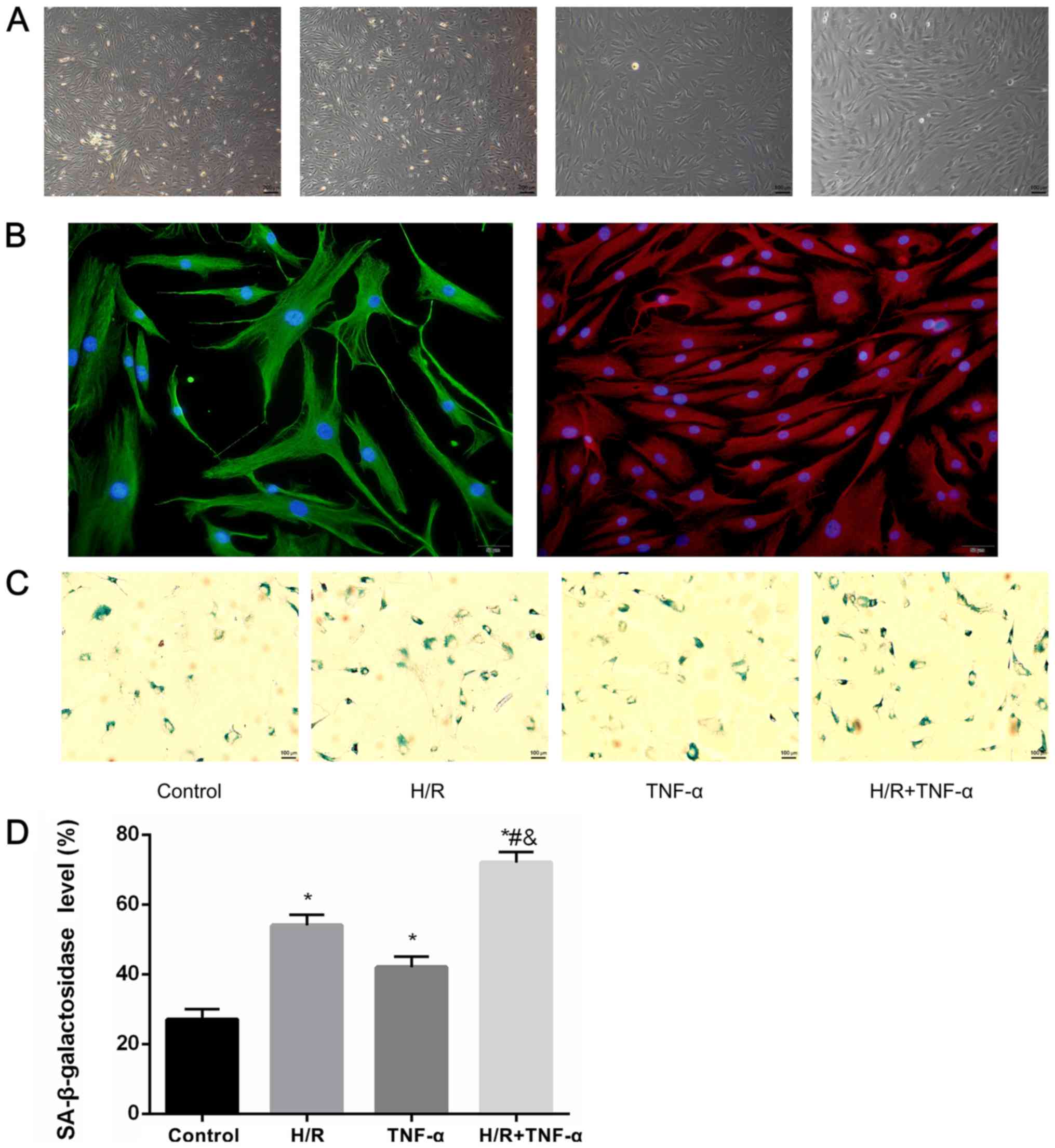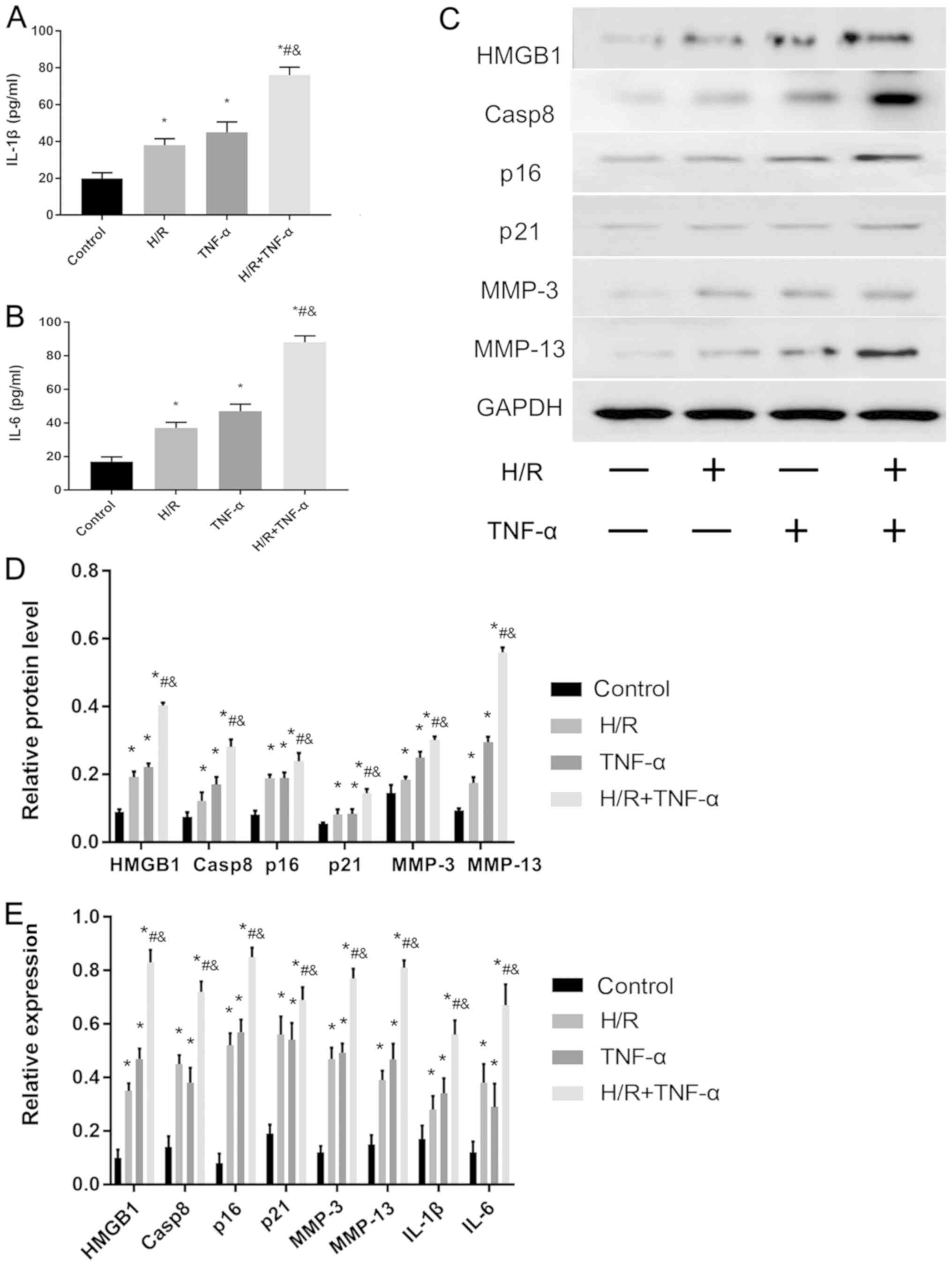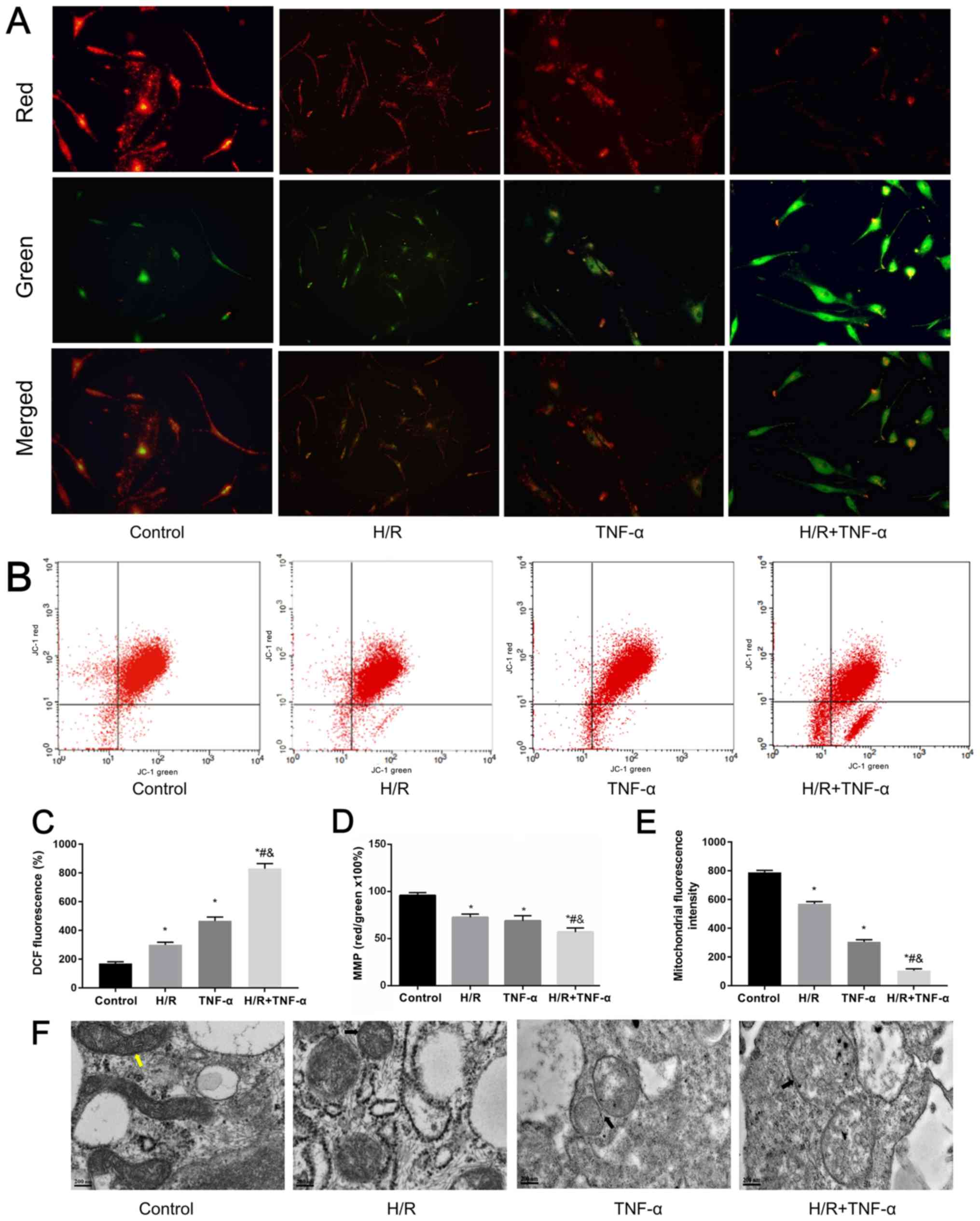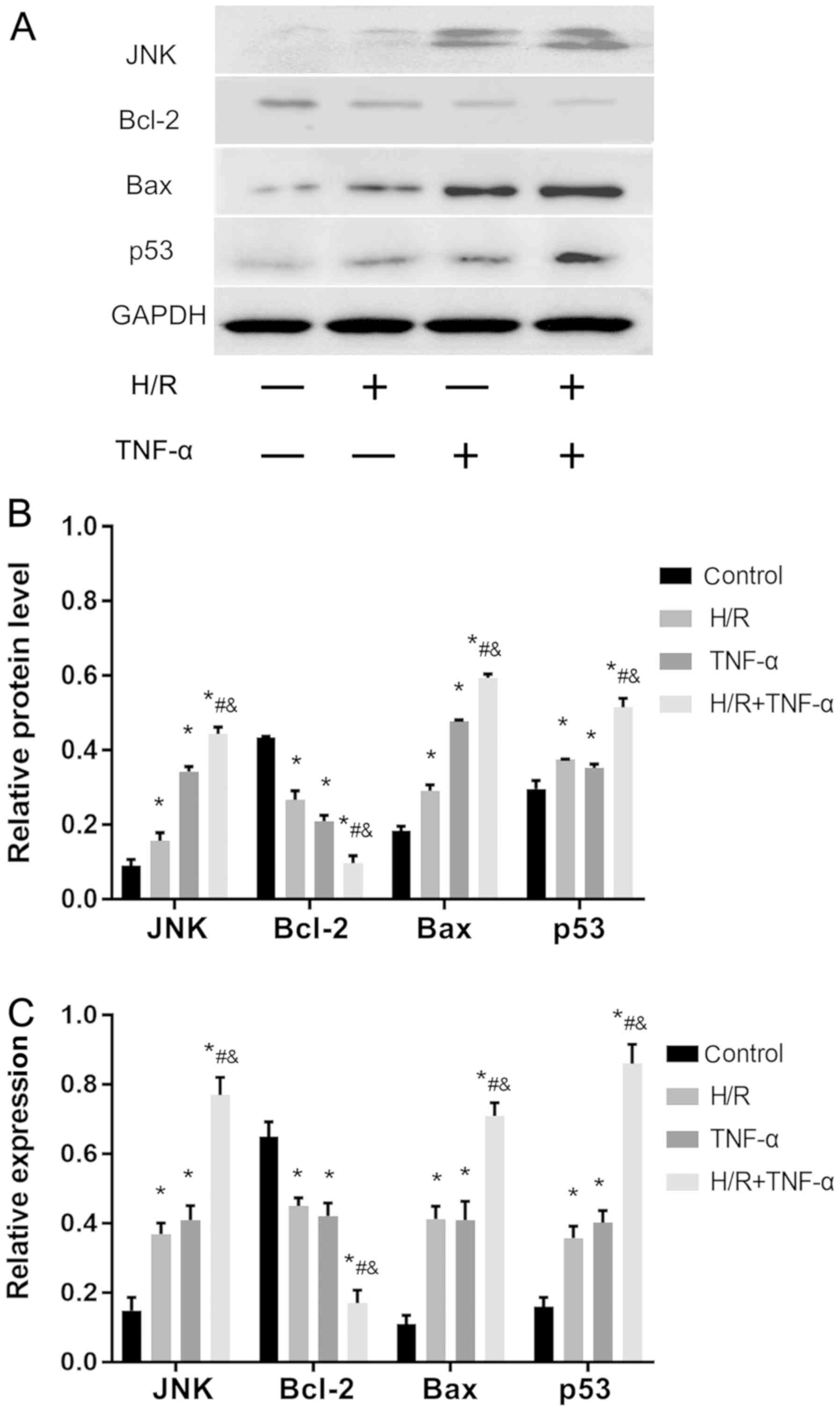|
1
|
Xia B, Di Chen, Zhang J, Hu S, Jin H and
Tong P: Osteoarthritis pathogenesis: A review of molecular
mechanisms. Calcif Tissue Int. 95:495–505. 2014. View Article : Google Scholar : PubMed/NCBI
|
|
2
|
Bijlsma JW, Berenbaum F and Lafeber FP:
Osteoarthritis: An update with relevance for clinical practice.
Lancet. 377:2115–2126. 2011. View Article : Google Scholar : PubMed/NCBI
|
|
3
|
Loeser RF, Goldring SR, Scanzello CR and
Goldring MB: Osteoarthritis: A disease of the joint as an organ.
Arthritis Rheum. 64:1697–1707. 2012. View Article : Google Scholar : PubMed/NCBI
|
|
4
|
Scanzello CR and Goldring SR: The role of
synovitis in osteoarthritis pathogenesis. Bone. 51:249–257. 2012.
View Article : Google Scholar : PubMed/NCBI
|
|
5
|
Charlier E, Deroyer C, Ciregia F, Malaise
O, Neuville S, Plener Z, Malaise M and de Seny D: Chondrocyte
dedifferentiation and osteoarthritis (OA). Biochem Pharmacol.
165:49–65. 2019. View Article : Google Scholar : PubMed/NCBI
|
|
6
|
Nakamura H, Shimamura S, Yasuda S, Kono M,
Kono M, Fujieda Y, Kato M, Oku K, Bohgaki T, Shimizu T, et al:
Ectopic RASGRP2 (CalDAG-GEFI) expression in rheumatoid synovium
contributes to the development of destructive arthritis. Ann Rheum
Dis. 77:1765–1772. 2018. View Article : Google Scholar : PubMed/NCBI
|
|
7
|
Chubinskaya S, Frank BS, Michalska M,
Kumar B, Merrihew CA, Thonar EJ, Lenz ME, Otten L, Rueger DC and
Block JA: Osteogenic protein 1 in synovial fluid from patients with
rheumatoid arthritis or osteoarthritis: Relationship with disease
and levels of hyaluronan and antigenic keratan sulfate. Arthritis
Res Ther. 8:R732006. View
Article : Google Scholar : PubMed/NCBI
|
|
8
|
Yin S, Zhang L, Ding L, Huang Z, Xu B, Li
X, Wang P and Mao J: Transient receptor potential ankyrin 1 (trpa1)
mediates il-1β-induced apoptosis in rat chondrocytes via calcium
overload and mitochondrial dysfunction. J Inflamm (Lond).
15:272018. View Article : Google Scholar : PubMed/NCBI
|
|
9
|
Del RM MJ, Izquierdo E, Caja S, Usategui
A, Santiago B, Galindo M and Pablos JL: Human inflammatory synovial
fibroblasts induce enhanced myeloid cell recruitment and
angiogenesis through a hypoxia-inducible transcription factor
1alpha/vascular endothelial growth factor-mediated pathway in
immunodeficient mice. Arthritis Rheum. 60:2926–2934. 2009.
View Article : Google Scholar : PubMed/NCBI
|
|
10
|
Riis RG, Gudbergsen H, Simonsen O,
Henriksen M, Al-Mashkur N, Eld M, Petersen KK, Kubassova O, Bay
Jensen AC, Damm J, et al: The association between histological,
macroscopic and magnetic resonance imaging assessed synovitis in
end-stage knee osteoarthritis: A cross-sectional study.
Osteoarthritis Cartilage. 25:272–280. 2017. View Article : Google Scholar : PubMed/NCBI
|
|
11
|
Wang Y, Liu Y, Fan Z, Liu D, Wang F and
Zhou Y: IGFBP2 enhances adipogenic differentiation potentials of
mesenchymal stem cells from Wharton's jelly of the umbilical cord
via JNK and Akt signaling pathways. PLoS One. 12:e1841822017.
|
|
12
|
Mathy-Hartert M, Burton S, Deby-Dupont G,
Devel P, Reginster JY and Henrotin Y: Influence of oxygen tension
on nitric oxide and prostaglandin E2 synthesis by bovine
chondrocytes. Osteoarthritis Cartilage. 13:74–79. 2005. View Article : Google Scholar : PubMed/NCBI
|
|
13
|
June RK, Liu-Bryan R, Long F and Griffin
TM: Emerging role of metabolic signaling in synovial joint
remodeling and osteoarthritis. J Orthop Res. 34:2048–2058. 2016.
View Article : Google Scholar : PubMed/NCBI
|
|
14
|
Zhou S, Wen H, Cai W, Zhang Y and Li H:
Effect of hypoxia/reoxygenation on the biological effect of IGF
system and the inflammatory mediators in cultured synoviocytes.
Biochem Biophys Res Commun. 508:17–24. 2019. View Article : Google Scholar : PubMed/NCBI
|
|
15
|
Chenevier-Gobeaux C, Simonneau C,
Lemarechal H, Bonnefont-Rousselot D, Poiraudeau S, Rannou F,
Ekindjian OG, Anract P and Borderie D: Effect of
hypoxia/reoxygenation on the cytokine-induced production of nitric
oxide and superoxide anion in cultured osteoarthritic synoviocytes.
Osteoarthritis Cartilage. 21:874–881. 2013. View Article : Google Scholar : PubMed/NCBI
|
|
16
|
Grishko VI, Ho R, Wilson GL and Pearsall
AW IV: Diminished mitochondrial DNA integrity and repair capacity
in OA chondrocytes. Osteoarthritis Cartilage. 17:107–113. 2009.
View Article : Google Scholar : PubMed/NCBI
|
|
17
|
Toussaint O, Dumont P, Dierick JF, Pascal
T, Frippiat C, Chainiaux F, Magalhaes JP, Eliaers F and Remacle J:
Stress-induced premature senescence as alternative toxicological
method for testing the long-term effects of molecules under
development in the industry. Biogerontology. 1:179–183. 2000.
View Article : Google Scholar : PubMed/NCBI
|
|
18
|
Campisi J: Senescent cells, tumor
suppression, and organismal aging: Good citizens, bad neighbors.
Cell. 120:513–522. 2005. View Article : Google Scholar : PubMed/NCBI
|
|
19
|
Campisi J: Aging, cellular senescence, and
cancer. Annu Rev Physiol. 75:685–705. 2013. View Article : Google Scholar : PubMed/NCBI
|
|
20
|
Peilin W, Songsong T, Chengyu Z, Zhi C,
Chunhui M, Yinxian Y, Lei Z, Min M, Zongyi W, Mengkai Y, et al:
Directed elimination of senescent cells attenuates development of
osteoarthritis by inhibition of c-IAP and XIAP. Biochim Biophys
Acta Mol Basis Dis. 1865:2618–2632. 2019. View Article : Google Scholar : PubMed/NCBI
|
|
21
|
Koobatian MT, Liang MS, Swartz DD and
Andreadis ST: Differential effects of culture senescence and
mechanical stimulation on the proliferation and leiomyogenic
differentiation of MSC from different sources: Implications for
engineering vascular grafts. Tissue Eng Part A. 21:1364–1375. 2015.
View Article : Google Scholar : PubMed/NCBI
|
|
22
|
Biniecka M, Kennedy A, Fearon U, Ng CT,
Veale DJ and O'Sullivan JN: Oxidative damage in synovial tissue is
associated with in vivo hypoxic status in the arthritic joint. Ann
Rheum Dis. 69:1172–1178. 2010. View Article : Google Scholar : PubMed/NCBI
|
|
23
|
Krizhanovsky V, Yon M, Dickins RA, Hearn
S, Simon J, Miething C, Yee H, Zender L and Lowe SW: Senescence of
activated stellate cells limits liver fibrosis. Cell. 134:657–667.
2008. View Article : Google Scholar : PubMed/NCBI
|
|
24
|
Baker DJ, Wijshake T, Tchkonia T,
LeBrasseur NK, Childs BG, van de Sluis B, Kirkland JL and van
Deursen JM: Clearance of p16Ink4a-positive senescent cells delays
ageing-associated disorders. Nature. 479:232–236. 2011. View Article : Google Scholar : PubMed/NCBI
|
|
25
|
Acosta JC, Banito A, Wuestefeld T,
Georgilis A, Janich P, Morton JP, Athineos D, Kang TW, Lasitschka
F, Andrulis M, et al: A complex secretory program orchestrated by
the inflammasome controls paracrine senescence. Nat Cell Biol.
15:978–990. 2013. View
Article : Google Scholar : PubMed/NCBI
|
|
26
|
Basu S, Rajakaruna S, Reyes B, Van
Bockstaele E and Menko AS: Suppression of MAPK/JNK-MTORC1 signaling
leads to premature loss of organelles and nuclei by autophagy
during terminal differentiation of lens fiber cells. Autophagy.
10:1193–1211. 2014. View Article : Google Scholar : PubMed/NCBI
|
|
27
|
Wang X, Hunter DJ, Jin X and Ding C: The
importance of synovial inflammation in osteoarthritis: Current
evidence from imaging assessments and clinical trials.
Osteoarthritis Cartilage. 26:165–174. 2018. View Article : Google Scholar : PubMed/NCBI
|
|
28
|
Yao Y, Chen R, Ying C, Zhang G, Rui T and
Tao A: Interleukin-33 attenuates doxorubicin-induced cardiomyocyte
apoptosis through suppression of ASK1/JNK signaling pathway.
Biochem Biophys Res Commun. 493:1288–1295. 2017. View Article : Google Scholar : PubMed/NCBI
|
|
29
|
Kyriakis JM and Avruch J: Mammalian
mitogen-activated protein kinase signal transduction pathways
activated by stress and inflammation. Physiol Rev. 81:807–869.
2001. View Article : Google Scholar : PubMed/NCBI
|
|
30
|
Yang LW, Song M, Li YL, Liu YP, Liu C, Han
L, Wang ZH, Zhang W, Xing YQ and Zhong M: L-Carnitine inhibits the
senescence-associated secretory phenotype of aging adipose tissue
by JNK/p53 pathway. Biogerontology. 20:203–211. 2019. View Article : Google Scholar : PubMed/NCBI
|
|
31
|
Das M, Jiang F, Sluss HK, Zhang C, Shokat
KM, Flavell RA and Davis RJ: Suppression of p53-dependent
senescence by the JNK signal transduction pathway. Proc Natl Acad
Sci USA. 104:15759–15764. 2007. View Article : Google Scholar : PubMed/NCBI
|
|
32
|
Lanna A, Gomes DC, Muller-Durovic B,
McDonnell T, Escors D, Gilroy DW, Lee JH, Karin M and Akbar AN: A
sestrin-dependent Erk-Jnk-p38 MAPK activation complex inhibits
immunity during aging. Nat Immunol. 18:354–363. 2017. View Article : Google Scholar : PubMed/NCBI
|
|
33
|
Nelson G, Wordsworth J, Wang C, Jurk D,
Lawless C, Martin-Ruiz C and von Zglinicki T: A senescent cell
bystander effect: Senescence-induced senescence. Aging Cell.
11:345–349. 2012. View Article : Google Scholar : PubMed/NCBI
|
|
34
|
Livak KJ and Schmittgen TD: Analysis of
relative gene expression data using real-time quantitative PCR and
the 2(-Delta Delta C(T)) method. Methods. 25:402–408. 2001.
View Article : Google Scholar : PubMed/NCBI
|
|
35
|
Xia G, Wang X, Sun H, Qin Y and Fu M:
Carnosic acid (CA) attenuates collagen-induced arthritis in db/db
mice via inflammation suppression by regulating ROS-dependent p38
pathway. Free Radic Biol Med. 108:418–432. 2017. View Article : Google Scholar : PubMed/NCBI
|
|
36
|
Xin R, Pan YL, Wang Y, Wang SY, Wang R,
Xia B, Qin RN, Fu Y and Wu YH: Nickel-refining fumes induce NLRP3
activation dependent on mitochondrial damage and ROS production in
Beas-2B cells. Arch Biochem Biophys. 676:1081482019. View Article : Google Scholar : PubMed/NCBI
|
|
37
|
Kim JH, Jeon J, Shin M, Won Y, Lee M, Kwak
JS, Lee G, Rhee J, Ryu JH, Chun CH and Chun JS: Regulation of the
catabolic cascade in osteoarthritis by the zinc-ZIP8-MTF1 axis.
Cell. 156:730–743. 2014. View Article : Google Scholar : PubMed/NCBI
|
|
38
|
de Lange-Brokaar BJ, Ioan-Facsinay A, van
Osch GJ, Zuurmond AM, Schoones J, Toes RE, Huizinga TW and
Kloppenburg M: Synovial inflammation, immune cells and their
cytokines in osteoarthritis: A review. Osteoarthritis Cartilage.
20:1484–1499. 2012. View Article : Google Scholar : PubMed/NCBI
|
|
39
|
Mathiessen A and Conaghan PG: Synovitis in
osteoarthritis: Current understanding with therapeutic
implications. Arthritis Res Ther. 19:182017. View Article : Google Scholar : PubMed/NCBI
|
|
40
|
Schneider N, Mouithys-Mickalad AL, Lejeune
JP, Deby-Dupont GP, Hoebeke M and Serteyn DA: Synoviocytes, not
chondrocytes, release free radicals after cycles of
anoxia/re-oxygenation. Biochem Biophys Res Commun. 334:669–673.
2005. View Article : Google Scholar : PubMed/NCBI
|
|
41
|
Harper ME, Bevilacqua L, Hagopian K,
Weindruch R and Ramsey JJ: Ageing, oxidative stress, and
mitochondrial uncoupling. Acta Physiol Scand. 182:321–331. 2004.
View Article : Google Scholar : PubMed/NCBI
|
|
42
|
Musumeci G, Szychlinska MA and Mobasheri
A: Age-related degeneration of articular cartilage in the
pathogenesis of osteoarthritis: Molecular markers of senescent
chondrocytes. Histol Histopathol. 30:1–12. 2015. View Article : Google Scholar : PubMed/NCBI
|
|
43
|
Schulz E, Wenzel P, Munzel T and Daiber A:
Mitochondrial redox signaling: Interaction of mitochondrial
reactive oxygen species with other sources of oxidative stress.
Antioxid Redox Signal. 20:308–324. 2014. View Article : Google Scholar : PubMed/NCBI
|
|
44
|
Cillero-Pastor B, Martin MA, Arenas J,
López-Armada MJ and Blanco FJ: Effect of nitric oxide on
mitochondrial activity of human synovial cells. BMC Musculoskelet
Disord. 12:422011. View Article : Google Scholar : PubMed/NCBI
|
|
45
|
Lepetsos P and Papavassiliou AG:
ROS/oxidative stress signaling in osteoarthritis. Biochim Biophys
Acta. 1862:576–591. 2016. View Article : Google Scholar : PubMed/NCBI
|
|
46
|
Passos JF, Nelson G, Wang C, Richter T,
Simillion C, Proctor CJ, Miwa S, Olijslagers S, Hallinan J, Wipat
A, et al: Feedback between p21 and reactive oxygen production is
necessary for cell senescence. Mol Syst Biol. 6:3472010. View Article : Google Scholar : PubMed/NCBI
|
|
47
|
Strandberg TE and Tilvis RS: C-reactive
protein, cardiovascular risk factors, and mortality in a
prospective study in the elderly. Arterioscler Thromb Vasc Biol.
20:1057–1060. 2000. View Article : Google Scholar : PubMed/NCBI
|
|
48
|
Kaarniranta K, Pawlowska E, Szczepanska J,
Jablkowska A and Blasiak J: Role of Mitochondrial DNA Damage in
ROS-mediated pathogenesis of age-related macular degeneration
(AMD). Int J Mol Sci. 20(pii): E23742019. View Article : Google Scholar : PubMed/NCBI
|
|
49
|
Shay JW and Wright WE: Hayflick, his
limit, and cellular ageing. Nat Rev Mol Cell Biol. 1:72–76. 2000.
View Article : Google Scholar : PubMed/NCBI
|
|
50
|
Dalle PP, Nelson G, Otten EG, Korolchuk
VI, Kirkwood TB, von Zglinicki T and Shanley DP: Dynamic modelling
of pathways to cellular senescence reveals strategies for targeted
interventions. PLoS Comput Biol. 10:e10037282014. View Article : Google Scholar : PubMed/NCBI
|
|
51
|
Dhawan P and Richmond A: A novel NF-kappa
B-inducing kinase-MAPK signaling pathway up-regulates NF-kappa B
activity in melanoma cells. J Biol Chem. 277:7920–7928. 2002.
View Article : Google Scholar : PubMed/NCBI
|
|
52
|
Schattauer SS, Bedini A, Summers F,
Reilly-Treat A, Andrews MM, Land BB and Chavkin C: Reactive oxygen
species (ROS) generation is stimulated by κ opioid receptor
activation through phosphorylated c-Jun N-terminal kinase and
inhibited by p38 mitogen-activated protein kinase (MAPK)
activation. J Biol Chem. 294:16884–16896. 2019. View Article : Google Scholar : PubMed/NCBI
|
|
53
|
Craig R, Larkin A, Mingo AM, Thuerauf DJ,
Andrews C, McDonough PM and Glembotski CC: p38 MAPK and NF-kappa B
collaborate to induce interleukin-6 gene expression and release.
Evidence for a cytoprotective autocrine signaling pathway in a
cardiac myocyte model system. J Biol Chem. 275:23814–23824. 2000.
View Article : Google Scholar : PubMed/NCBI
|
|
54
|
Lories RJ, Derese I, Luyten FP and de Vlam
K: Activation of nuclear factor kappa B and mitogen activated
protein kinases in psoriatic arthritis before and after etanercept
treatment. Clin Exp Rheumatol. 26:96–102. 2008.PubMed/NCBI
|
|
55
|
Hsieh CC, Rosenblatt JI and
Papaconstantinou J: Age-associated changes in SAPK/JNK and p38 MAPK
signaling in response to the generation of ROS by 3-nitropropionic
acid. Mech Ageing Dev. 124:733–746. 2003. View Article : Google Scholar : PubMed/NCBI
|
|
56
|
Kanatsu-Shinohara M, Yamamoto T, Toh H,
Kazuki Y, Kazuki K, Imoto J, Ikeo K, Oshima M, Shirahige K, Iwama
A, et al: Aging of spermatogonial stem cells by Jnk-mediated
glycolysis activation. Proc Natl Acad Sci USA. 116:16404–16409.
2019. View Article : Google Scholar : PubMed/NCBI
|
|
57
|
Ge HX, Zou FM, Li Y, Liu AM and Tu M: JNK
pathway in osteoarthritis: Pathological and therapeutic aspects. J
Recept Signal Transduct Res. 37:431–436. 2017. View Article : Google Scholar : PubMed/NCBI
|
|
58
|
Twumasi-Boateng K, Wang TW, Tsai L, Lee
KH, Salehpour A, Bhat S, Tan MW and Shapira M: An age-dependent
reversal in the protective capacities of JNK signaling shortens
Caenorhabditis elegans lifespan. Aging Cell. 11:659–667. 2012.
View Article : Google Scholar : PubMed/NCBI
|
|
59
|
Olivotto E, Merli G, Assirelli E, Cavallo
C, Belluzzi E, Ramonda R, Favero M, Filardo G, Roffi A, Kon E and
Grigolo B: Cultures of a human synovial cell line to evaluate
platelet-rich plasma and hyaluronic acid effects. J Tissue Eng
Regen Med. 12:1835–1842. 2018. View Article : Google Scholar : PubMed/NCBI
|
|
60
|
Huhtakangas JA, Veijola J, Turunen S,
Karjalainen A, Valkealahti M, Nousiainen T, Yli-Luukko S,
Vuolteenaho O and Lehenkari P: 1,25(OH)2D3
and calcipotriol, its hypocalcemic analog, exert a long-lasting
anti-inflammatory and anti-proliferative effect in synoviocytes
cultured from patients with rheumatoid arthritis and
osteoarthritis. J Steroid Biochem Mol Biol. 173:13–22. 2017.
View Article : Google Scholar : PubMed/NCBI
|
|
61
|
Zhang L, Zhang L, Huang Z, Xing R, Li X,
Yin S, Mao J, Zhang N, Mei W, Ding L and Wang P: Increased HIF-1α
in Knee Osteoarthritis aggravate synovial fibrosis via
fibroblast-like synoviocyte pyroptosis. Oxid Med Cell Longev.
2019:63265172019.PubMed/NCBI
|
|
62
|
Hsu HC, Chang WM, Wu JY, Huang CC, Lu FJ,
Chuang YW, Chang PJ, Chen KH, Hong CZ, Yeh RH, et al: Folate
deficiency triggered apoptosis of synoviocytes: Role of
overproduction of reactive oxygen species generated via NADPH
Oxidase/Mitochondrial Complex II and calcium perturbation. PLoS
One. 11:e1464402016.
|
|
63
|
Gale AL, Mammone RM, Dodson ME, Linardi RL
and Ortved KF: The effect of hypoxia on chondrogenesis of equine
synovial membrane-derived and bone marrow-derived mesenchymal stem
cells. BMC Vet Res. 15:2012019. View Article : Google Scholar : PubMed/NCBI
|
|
64
|
Fernandes JC, Martel-Pelletier J and
Pelletier JP: The role of cytokines in osteoarthritis
pathophysiology. Biorheology. 39:237–246. 2002.PubMed/NCBI
|
|
65
|
Park J, Lee J, Kim KI, Lee J, Jang S, Choi
HT, Son Y, Kim HJ, Woo EJ, Lee E and Oh TI: A pathophysiological
validation of collagenase II-induced biochemical osteoarthritis
animal model in rabbit. Tissue Eng Regen Med. 15:437–444. 2018.
View Article : Google Scholar : PubMed/NCBI
|















